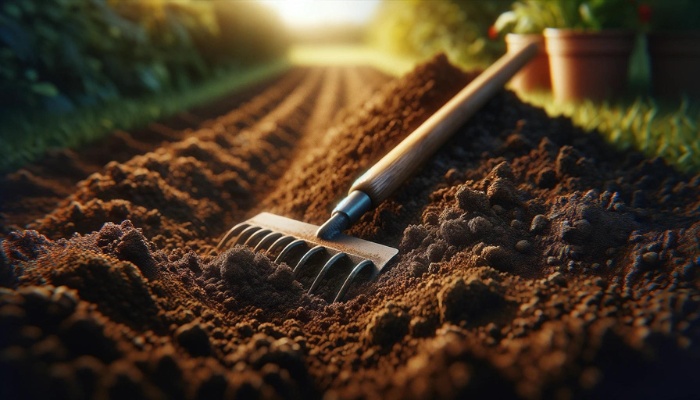For optimal plant health and growth in your square foot garden, you need a soil mix that balances compost, vermiculite, and peat moss.
This blend ensures essential nutrients, adequate water retention, and proper aeration. The pH should be between 6.0 and 7.0 for most vegetables.
Customizing and maintaining your soil mix is key to thriving plants. Discover how these tweaks make a significant difference.
Understanding Soil Composition
Understanding soil composition is key to creating a thriving square foot garden as it directly influences water retention, nutrient availability, and root development. Soil pH and mineral content are pivotal factors in this equation.
Soil pH, a measure of acidity or alkalinity, significantly affects how plants access nutrients.
Most garden vegetables thrive in a neutral to slightly acidic pH range (6.0-7.0), where essential nutrients like nitrogen, phosphorus, and potassium are most available.
Adjusting the pH to fit within this range ensures your plants can efficiently uptake nutrients, leading to healthier growth and increased yields.
The soil’s mineral content—comprising sand, silt, and clay—determines its texture and affects drainage and aeration.
A balance is key. For instance, clay soils retain moisture well but may inhibit root growth due to poor aeration. Conversely, sandy soils offer excellent aeration but may require frequent watering due to quick drainage.
Ideal Soil Mix Ingredients
To achieve optimal growth in your square foot garden, you’ll need to carefully select a soil mix that includes a balanced blend of compost, vermiculite, and peat moss.
This combination ensures your plants have access to the nutrients they need while maintaining the right moisture levels.
- Compost enriches the soil with essential nutrients, supporting plant health and growth.
- Vermiculite, a natural mineral, aids in water retention and aeration, preventing the compaction of the soil.
- Peat moss regulates moisture and air around plant roots and helps maintain an ideal soil pH.
Soil pH affects nutrient availability to plants. A slightly acidic to neutral pH, typically between 6.0 and 7.0, is optimal for most garden vegetables, ensuring they can absorb the nutrients efficiently.
Furthermore, the structure of this soil mix minimizes nutrient-leaching effects.
Nutrient leaching—the loss of water-soluble plant nutrients from the soil—can be a significant issue, especially in sandy soils.
By using this mix, you’ll create a stable environment that retains nutrients, ensuring your plants remain healthy and productive.
Creating Your Mix at Home
Creating your own square foot garden soil mix at home allows you to tailor the nutrient content and texture to your plants’ specific needs, ensuring optimal growth and health.
This DIY approach promises a customized substrate and offers significant cost efficiency compared to the pre-mixed solutions available. However, venturing into homemade soil mix creation presents its own set of challenges.
A common recipe involves blending one-third peat moss or coconut coir for water retention, one-third vermiculite for aeration, and one-third compost to provide a wide array of nutrients.
Achieving the right proportions is key to fostering a thriving garden.
Despite the apparent simplicity, DIY soil mix preparation requires precision. Inaccurate measurements can lead to waterlogged or nutrient-deficient soil, impacting plant health.
Additionally, sourcing quality ingredients is fundamental. Poor-quality compost or improperly sterilized components may introduce pathogens or pests into your garden.
Adjusting for Plant Needs
Considering the diverse nutritional and environmental needs of various plants, it’s important to adjust your square foot garden soil mix accordingly.
The pH level of your soil directly influences nutrient availability. Most vegetables thrive in a slightly acidic to neutral pH range (6.0 to 7.0).
However, some plants, like blueberries, require more acidic conditions. You can lower the pH with sulfur or raise it with lime, but it’s essential to test your soil’s pH before making adjustments.
Watering frequency is another critical factor that depends on your soil mix’s composition. Sandy soil drains quickly and requires more frequent watering, while clay-heavy soil retains moisture longer but risks waterlogging.
To strike a balance, incorporate organic matter like compost, which improves water retention in sandy soil and increases drainage in clay soil. Remember that consistent moisture levels are key to preventing stress and promoting healthy growth.
Maintenance and Troubleshooting
Regular monitoring of your square foot garden’s soil conditions is vital for identifying and addressing any issues promptly, ensuring your plants remain healthy and productive.
A key aspect of maintenance involves adjusting watering frequency based on the soil’s moisture content and the weather conditions. Overwatering can lead to root rot, and underwatering stresses plants, hindering their growth.
Implementing effective pest control strategies is another key component. Early detection and intervention can prevent pests from causing irreparable damage to your garden. Here are essential maintenance and troubleshooting tips:
- Monitor soil moisture levels regularly to adjust watering schedules accordingly.
- Inspect plants frequently for signs of pest infestation or disease.
- Introduce beneficial insects or use organic pesticides for environmentally friendly pest control.
- Amend the soil periodically with compost to replenish nutrients and maintain optimal soil structure.
- Rotate crops in your square foot garden to prevent soil-borne diseases and pest infestations.

